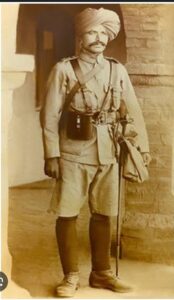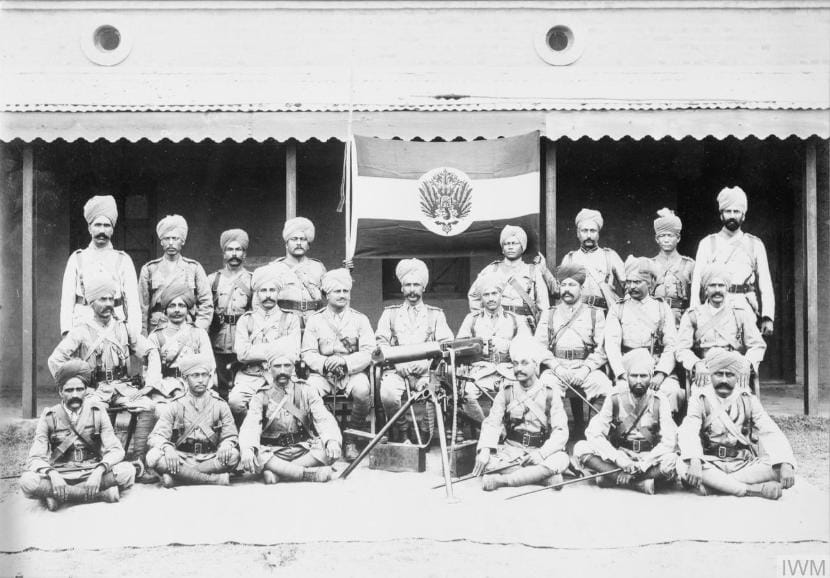From the rugged mountains of Aksai Chin to international peacekeeping missions, the Jammu and Kashmir Rifles stand as a testament to bravery and resilience, earning numerous honors for their gallant service.
By Zahid Iqbal Sheikh
The Jammu and Kashmir Rifles stand as a bastion of courage, bravery, and sacrifice, reflecting the rich amalgamation of the erstwhile princely state of Jammu and Kashmir’s martial traditions. The Jammu and Kashmir State Force is an umbrella term that encompasses all sections of the army in the erstwhile princely state of Jammu and Kashmir, which is now a Union Territory. The Jammu and Kashmir Rifles, a distinguished infantry regiment within the Indian Army, originates from the Jammu and Kashmir State Forces, which served the princely state of Jammu and Kashmir.
With the state’s integration into the Indian Union in October 1947, the State Forces were brought under the command of the Indian Army. This arrangement remained unchanged until 1956 when the Jammu and Kashmir Constituent Assembly officially endorsed the state’s accession to India. Consequently, the State Forces underwent a transformation, becoming recognized as the Jammu and Kashmir Regiment within the Indian Army. The year 1963 marked a significant milestone as the regiment was rechristened as the Jammu and Kashmir Rifles, with its headquarters at Jabalpur in Madhya Pradesh. As part of this transition, the Ladakh Scouts, previously under the purview of the Regiment, were eventually established as a separate entity in 2002. This journey underscores the regiment’s evolution and its enduring commitment to serving the nation.
The origins of this illustrious regiment can be traced back to the era of Ranjit Singh (1801-1839), who annexed Jammu to the Khalsa Durbar. Gulab Singh, who ruled from 1846-1856, joined Ranjit Singh’s army in 1809 as an ordinary soldier, on the recommendation of Bhai Hukam Singh, according to Alexander Cunningham. Gulab Singh showcased his prowess in the expeditions of Multan (1818), Kashmir (1819), Mankera, Dera Ghazi Khan (1819-20), and Kishtwar (1821), becoming an important grandee at the Sikh Durbar. His loyalty and competence earned him the confidence of Ranjit Singh, who bestowed upon him the Jagir of Jammu with the title of Raja in the Raj Tilak ceremony held at Akhnoor on 17th January 1822.
Earlier, in 1815, when Gulab Singh was awarded the Jagirs of Lala Chowbara and Ramgarh, he raised a company of 200 soldiers to maintain law and order in his Jagirs. This was the first attempt to raise a proper armed force to maintain law and order, but the first armed force of any consequence seems to have been raised only in 1822. When Gulab Singh became Raja of Jammu, he was expected to keep a small regular army of horse and foot soldiers to be presented at the Dussehra festival for review at Lahore. Although we do not have an exact figure of the army maintained by Gulab Singh at that time, British accounts of Punjab mention that it had 5,000 troops in 1842.

Over time, Ranjit Singh became more confident about the loyalty of Gulab Singh. The greatest impetus to the development of the Jammu Army came from the policy of territorial expansion pursued by the new Raja of Jammu. This expansionist policy of Gulab Singh in Ladakh and Tibet was implemented by one of his powerful generals, Zorawar Singh. This period of growth and consolidation laid the foundation for what would eventually become the proud and valorous Jammu and Kashmir Rifles, an integral part of the Indian Army.
During the British Raj, the Maharaja of Jammu and Kashmir commanded an extensive array of State Forces, surpassing the military force maintained by rulers of other Indian states. Maharaja Ranbir Singh (1856-85) is said to have had around 26,000 armed forces in 1860, which was raised to 30,000 by 1870. These forces were meticulously organized into what was known as the Jammu and Kashmir Brigades. Comprising a diverse range of units, they included a cavalry regiment tasked with the vital role of guarding, two mountain batteries equipped for challenging terrains, seven infantry battalions embodying strength and resilience, a dedicated training battalion, and a comprehensive transport unit comprising both pack and mechanized transport systems.
Maintaining the Imperial Service Troops at the required level of efficiency was a costly affair, and to keep the defense budget within tolerable limits, a reduction in the overall strength of the State Army became necessary. The strength of the State Army, which stood at 22,398 at the end of 1888, was first slashed to 8,955 all ranks in 1890, of which 4,904 comprised the Imperial Service Corps and the remainder the ‘Regulars’. Such large-scale reductions created a significant human problem, which was tackled with great tact and sympathy by the Commander-in-Chief, Raja Ram Singh, and the concerned State officers.
Remarkably, several of these units etched their names in history by showcasing valor and skill on the North-West Frontier of India and beyond during the tumultuous period of the Great War. Serving with distinction, they displayed unparalleled courage and commitment on various fronts. More than two thousand six hundred state forces under the command of Diwan Hari helped the British to quell the revolt of 1857 in Delhi. Their contributions extended beyond Indian borders, as they participated as Imperial Service Troops in both the First and Second World Wars, led by their own native officers. Notably, they left an indelible mark in far-flung regions such as East Africa, Palestine, and Burma, where their bravery and resolve earned them widespread recognition and acclaim.

In the wake of the birth of two sovereign nations, India and Pakistan, the enigmatic question of Kashmir’s allegiance emerged as a pivotal concern, beckoning ponderance over which realm it would align itself with. The Maharaja of Kashmir ultimately chose to join India. The escalation between the two countries led to the first Indo-Pak war in 1947, during which the state forces fought hand-in-hand with the Indian Army. Amidst the tumultuous Indo-Pakistani War of 1947, predominantly waged in the region, the toll of conflict bore heavy casualties, with the loss of 76 officers, 31 Junior Commissioned Officers (JCOs), and 1,085 Other Ranks on the battlefield. Courage and gallantry shone amidst the chaos, as 2 Param Vir Chakras, 3 Maha Vir Chakras, and 20 Vir Chakras were rightfully earned, with 52 valiant members of the regiment Mentioned in Despatches for their commendable deeds.
In the aftermath, a pivotal chapter unfolded as the Jammu and Kashmir State Force underwent a transformative absorption into the Indian Army as an autonomous regiment, marking a significant milestone in its storied history. In the rugged mountains of Aksai Chin during the 1962 Sino-Indian War, two battalions from the Jammu and Kashmir Rifles formed India’s frontline, bolstered by a regular army battalion. Despite facing overwhelming odds, they fought valiantly against a massive Chinese division, earning praise for their exceptional performance from scholar Steven Hoffman.
During the period spanning from 1990 to 1993, a battalion hailing from the Jammu and Kashmir Rifles regiment served as an integral component of the United Nations peacekeeping force stationed in Cambodia. This further highlighted their adaptability and commitment to global peace and security, reinforcing their esteemed reputation on the international stage. The regiment’s rich history and continued dedication to duty underscore its vital role in both national defense and international peacekeeping efforts.
A significant portion of the Army’s Jammu and Kashmir Light Infantry and Jammu and Kashmir Rifles Regiments comprises recruits originating from districts such as Jammu, Samba, Kathua, Udhampur, and Reasi. It would not be wrong to mention that this region served as the “Military Labour Market,” in the words of historian Dik H. A. Kolff, for the State forces as well as the Jammu and Kashmir Rifles. Additionally, districts like Poonch, Rajouri, Doda, and Kishtwar also make notable contributions to the ranks. Soldiers hailing from regions like Himachal Pradesh, Punjab, Uttarakhand, Uttar Pradesh, Bihar, and Haryana also play a crucial role in bolstering the strength of these regiments.
In essence, the Jammu and Kashmir Rifles stand as a testament to the indomitable spirit and resilience of its soldiers, who have braved the rigors of conflict and adversity with unwavering courage and determination. These soldiers, drawn from diverse backgrounds, unite under a common banner, embodying the rich tapestry of India’s martial traditions. Their valor is not confined to the borders of Jammu and Kashmir but extends to every corner of the nation and beyond, where they serve with distinction.
As guardians of the nation’s frontiers and custodians of its heritage, the regiment continues to uphold the highest traditions of military service. They serve not just as defenders but as symbols of hope and resilience, inspiring future generations to uphold the values of duty, honor, and sacrifice. Whether facing the harsh conditions of high-altitude warfare or participating in international peacekeeping missions, the soldiers of the Jammu and Kashmir Rifles exemplify dedication and excellence.
Their legacy is built on countless acts of bravery and an unwavering commitment to the nation. This enduring legacy ensures that the regiment remains a pillar of strength and a source of pride for the Indian Army and the country as a whole. The stories of their heroic deeds are a reminder of the sacrifices made to protect the sovereignty and integrity of India, inspiring all who hear them to honor and emulate such exemplary service.
The views expressed in this article are solely those of the author and do not necessarily reflect the opinions or views of this Magazine. The author can be reached at [email protected]

Leave a Reply